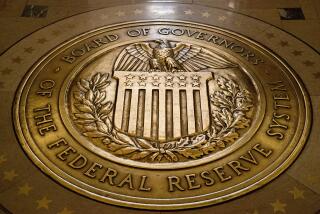Federal Reserve is expected to announce new bond-buying program
Nervous global investors can’t seem to own enough U.S. Treasury debt, yet the Federal Reserve may soon make the bonds even more scarce.
With the U.S. economy struggling, Fed policymakers are expected this week to announce a new bond-buying plan specifically aimed at pulling long-term interest rates lower.
That could help some Americans buy homes or refinance mortgages. But Wall Street doesn’t see much hope that the Fed can give a significant boost to the economy.
“Interest rates already are low and it hasn’t had any stimulative effect” on most consumers or businesses, said Dan Greenhaus, chief global strategist at brokerage BTIG in New York.
Still, many bond investors believe that the Fed has little choice but to provide what aid it can to the economy, with the Obama administration and Congress battling over fiscal policy.
On Monday, another slump in stocks worldwide helped drive investors back to Treasury bonds as a haven. Traders said some investors also were buying bonds ahead of the Fed’s two-day meeting, which begins Tuesday.
The annualized yield on 30-year Treasury bonds dived to 3.22%, down from 3.31% on Friday and the lowest since January 2009 — the depths of the last recession. The 10-year Treasury note yield, a benchmark for mortgage rates, slid to 1.95%, down from 2.05% on Friday and near the generational low of 1.92% reached Sept. 9.
Bond rates fall as the prices of the securities rise.
Treasury yields plummeted for much of August amid a wild rush of buying, as Europe’s debt crisis worsened and the U.S. economy showed signs of slowing markedly. Even though credit rating firm Standard & Poor’s downgraded the U.S. debt rating in early August for the first time in history, Treasuries kept their status as one of the world’s favorite hiding places in times of market turmoil.
As the economic outlook dimmed, Wall Street also began to focus on what else the Fed could do to bolster growth.
Fed Chairman Ben S. Bernanke has signaled that the central bank could resurrect a move it undertook in the 1960s known as Operation Twist: The Fed, which owns $1.6 trillion in Treasuries, could shift that portfolio by selling shorter-term debt and using the proceeds to buy longer-term bonds.
The net effect, the Fed hopes, would be to twist the so-called yield curve, meaning the level of longer-term interest rates compared with short-term rates. In theory, by adding to demand for longer-term Treasury bonds, the Fed could pull those rates down further. That could translate into lower rates on corporate, municipal and mortgage bonds.
Investment bank Credit Suisse expects the Fed to commit to a six-month program of buying $60 billion a month of Treasury debt maturing in seven and 10 years, said Scott Sherman, a Treasury debt strategist at the firm in New York. The Fed would sell bonds maturing in one to three years to finance its purchases of longer-term securities, he said.
Even though the Fed would be selling shorter-term debt in the marketplace, any upward pressure on short-term Treasury interest rates could be limited because the Fed in August said it was likely to keep its benchmark rate near zero through at least mid-2013.
The Treasury bond market isn’t showing any fear of higher short-term rates. The two-year T-note yield fell to a new low of 0.16% on Monday from 0.17% on Friday.
If the Fed commits to a new Operation Twist, it would be the third bond-buying program it has launched since November 2008. The last one was a $600-billion purchase program completed in June.
The difference this time is that most analysts believe that the Fed won’t print new money to fund its purchases. If the central bank merely swaps shorter-term Treasuries for longer-term securities, the net amount of its holdings won’t change.
Bernanke thereby might avoid criticism from Republican leaders, including Texas Gov. Rick Perry, who have said the Fed’s efforts to pump more money into the economy could eventually stoke inflation.
“There are certainly political constraints on what the Fed can do now,” BTIG’s Greenhaus said.
One question Bernanke has to ponder is how much lower longer-term rates can go, even with the Fed pushing on them. Because investors have been betting on a new Operation Twist, bond yields already reflect some of the potential benefit of greater Fed purchases, traders say.
That also happened last fall: The Fed’s $600-billion bond purchase program launched in November had been well-telegraphed. The 10-year T-note yield fell as low as 2.38% in October 2010 — then surged to 3.30% by year’s end despite the Fed’s bond buying.
But some analysts say they doubt that Treasury yields will suddenly rebound this time around because there is little faith that the economy will pick up speed any time soon. What’s more, Europe’s debt debacle remains a major risk for the global financial system, keeping stock markets on edge and encouraging more investors to favor bonds.
The Dow Jones industrials fell 108.08 points, or 0.9%, to 11,401.01 on Monday, after rallying 4.7% last week. The Dow pared a loss of 254 points Monday after Greece, which is desperate for more financial aid to avoid a debt default, said it was having productive talks with Eurozone leaders.
But later in the day Standard & Poor’s downgraded Italy’s credit rating to A from A+, a reminder of the risk that Europe’s debt crisis could continue to spread, which could further boost demand for Treasury bonds as a haven.






